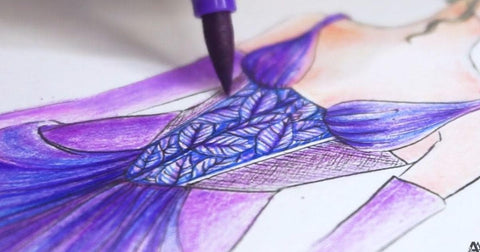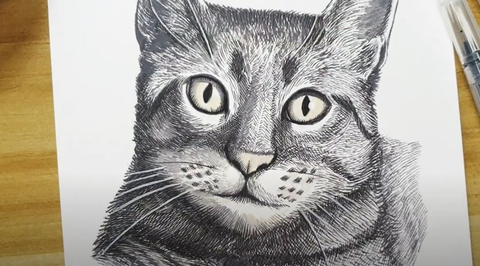How to Draw Cat Fur: A Beginner's Guide to Realistic Pencil Art
Last Updated: June 5, 2025
Drawing a realistic cat might seem like a complicated task, but it doesn't have to be! If you're curious about how to draw a cat or how to draw fur that looks soft, fluffy, and lifelike, you've landed in the purr-fect place.
In this blog, we’ll walk you through how to draw cat fur using simple tools, making it approachable and fun, especially if you're new to drawing.
What You’ll Need Before You Start

To get started, here’s a list of materials perfect for fur drawing and pencil art:
-
Must-have Gel Pen Set
-
Fine Liner Pen Set
-
Retractable Eraser
-
Watercolor Brush Medium
Remember, you don’t need the most expensive supplies to create stunning pencil drawings. Start with what you have!

Step-by-Step: How to Draw Cat Fur
Drawing fur might seem tricky, but once you understand the layering and direction techniques, it becomes a relaxing and rewarding experience. Let’s walk through how to draw cat fur using just a few essential tools, including watercolor brush markers, pencils, and beginner-friendly techniques like hatching and shading.

1. Start With a Light Sketch Using a 2H Pencil
Begin by sketching the overall pose and shape of your cat using a 2H pencil. This harder pencil grade is perfect for creating light lines that are easy to erase or paint over later.
-
Focus on proportion and basic anatomy: gently block in the head, body, ears, and tail.
-
Don’t rush. This stage sets the foundation for your realistic cat.
-
Observe your reference photo carefully and include as many structural details as you can, especially where the light hits and shadows fall. These areas will guide your fur texture later on.

2. Define Facial Features and Mark Shadow Zones
-
Once your basic shape is in place, refine the cat’s eyes, nose, mouth, and ear placement. These features will bring your feline friend to life.
-
Lightly shade in areas where shadows will go, such as under the chin, behind the ears, or the chest area.
-
Keep your lines soft and build your sketch gradually. This isn’t just a placeholder—your sketch will act as the blueprint for painting and detailing later.

3. Add Fur Direction Guides
To create realistic fur drawings, it's essential to understand the flow of fur.
-
Lightly draw directional arrows or guiding lines that show how the fur moves across the body.
-
Fur often curves outwards around the cheeks and forehead. Along the spine and tail, it flows more smoothly in one direction.
-
These lines will help you use the correct brush strokes and pencil movements later.

4. Start Painting the Fur with the Evening Gray Brush Marker
Now comes the fun part—fur painting! Use Evening Gray from your Altenew Watercolor Brush Markers.
-
Begin using hatching, a technique where closely spaced parallel lines create the illusion of soft texture.
-
Apply these strokes following the fur direction from your sketch.
-
For areas that need darker tones (like the backs of ears or under the chin), you can use cross-hatching—intersecting sets of parallel lines—to build shadow depth.

5. Dilute for Shading and Build Form
To soften the look and add subtle shading:
-
Dilute the Evening Gray by squeezing it onto a palette and applying it with a medium-sized water brush.
-
Use this diluted gray to gently wash areas where natural shadows fall or to blend hatching lines together.
-
Don’t forget to leave some areas untouched—this preserved white space becomes your highlight zones for shiny fur, especially around the eyes and cheeks.

6. Paint in Details: Eyes, Nose, and Stripes
-
Add life to your drawing by painting in the eyes, nose, and mouth.
-
Use slightly darker tones of gray or layer hatching for depth.
-
You can also add striping or tabby markings on the face and body by layering fine, directional strokes.
-
These markings should follow the natural curve of the cat’s body and fur direction to look realistic.

7. Add Highlight Details with a White Gel Pen
To create a lifelike finish, use a white Must-Have Gel Pen:
-
Add whiskers, sparkle in the eyes, and stray white hairs along the edges of the ears or muzzle.
-
A few well-placed white lines can completely transform your fur drawing from flat to fluffy!

8. Final Touches With a Fine Liner Pen
Wrap up your fur drawing with a Fine Liner Pen:
-
Emphasize the pupils, nostrils, mouth, and darkest fur shadows.
-
You can also outline some areas lightly to clean up your sketch and add definition where needed.
Don’t stress over perfection. Cats have wild, fluffy, and uneven fur. Embrace a bit of messiness!
Take breaks. Come back with fresh eyes and notice where shadows or fur lines need softening.
Practice with patches. Before drawing a full cat, try creating a small patch of fur using hatching and shading techniques.
This method blends the freedom of watercolor with the precision of pencil drawings, giving you the best of both worlds. And remember, you don't need professional-grade supplies to create stunning, realistic fur drawings. With your pencil, a brush marker, and a bit of practice, you’ll be crafting purr-fect cat portraits in no time.
Quick Tips to Improve Your Fur Drawing
-
Less is more. Don’t try to draw every hair. Focus on patterns, flow, and value contrast.
-
Use varied pressure. Light pressure for soft fur, heavier for coarse or shadowed areas.
-
Practice with reference photos. Every cat is unique. Observe where the fur clumps, flattens, or shines.
Drawing Fur with Colored Pencils
How to draw fur with a color pencil? Layer your colored pencil strokes the same way you would with graphite. Use light pressure, gradually building layers from light to dark. Try white or cream-colored pencils for highlights and black or brown for shadows. Always follow the fur direction!

How to Draw Fur on a Dog
The same techniques apply—just adjust for length and texture. Dog fur can be shaggier or curlier, so watch your reference photo carefully. Use longer strokes for Golden Retrievers or tighter, choppy lines for a Poodle.
Tip: Why not turn your cat fur drawing into a greeting card, framed gift, or art journal entry? Pair it with Altenew’s Fine Liner Pen Set or try watercoloring the background to make your furry friend stand out. This is a fantastic way for you to blend illustration into paper crafting!
 Learn How to Draw Fur Today with Just a Pencil!
Learn How to Draw Fur Today with Just a Pencil!
Drawing realistic cat fur might feel intimidating at first, but with a little patience (and some adorable reference photos), you'll be amazed at how lifelike your pencil art can look. Just remember that every stroke brings your sketch to life, and every attempt improves your technique.
Grab your best drawing pencils and start your fur drawing journey today. Find more sketching and coloring ideas and inspiration in The Creative Corner.
Frequently Asked Questions
Q: How do you draw basic fur?
Start with light, directional pencil strokes. Build layers using soft shading and contrast to mimic texture and volume.
Q: How can I get better at drawing fur?
Practice is key. Try drawing fur in small swatches or blocks before attempting full animals. Analyze how light hits real fur.
Q: What are the best drawing pencils for fur drawing?
Use a combination of HB, 2B, and 4B pencils. Mechanical pencils are great for fine details, while wood pencils are ideal for shading and layering.







